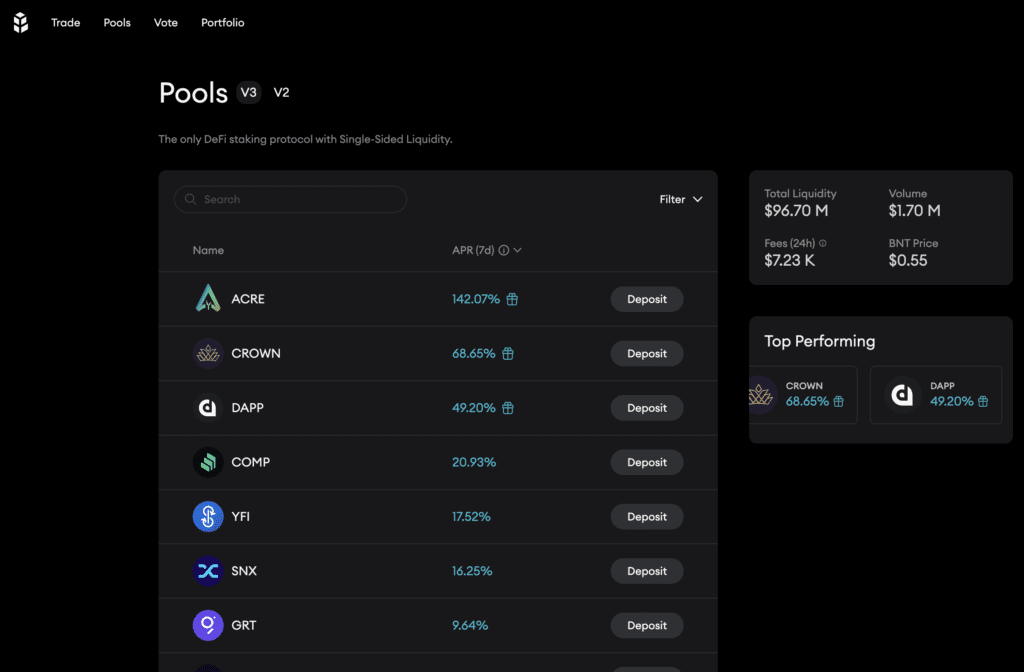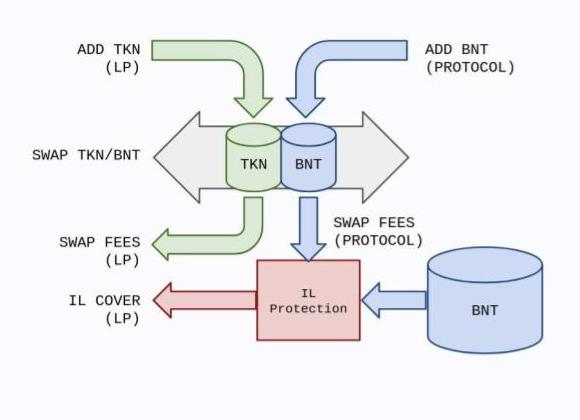Bancor Network Review: Big Step In DeFi, Providing Liquidity By Smart Contract
As a decentralized finance (DeFi) platform that has been in the crypto market for a long time and has unique characteristics that attract many investors, Bancor has demonstrated its value by placing its BNT currency in the top 300 coins in the world in terms of capitalization. Let’s learn details about this project with Coincu through this Bancor Network Review article.

This initiative is, in fact, one of the most well-known in the cryptocurrency sector. It has also seen its share of ups and downs. From a massive ICO to legal squabbles. From broad collaborations to a publicly known breach.
Bancor enables users to immediately convert between two tokens without the requirement for a counterparty. This is all done inside the Bancor wallet, and it is via this approach that Bancor is able to give traders automated liquidity for deals.
Most crucially, it permits the network to remain totally decentralized, with much of the network’s functioning owing to the novel usage of the BNT token to effectuate transactions.
So far, so good, but in order to grasp the true weight of Bancor, we must first examine its somewhat dramatic past.
Thus, to learn more about Bancor, whether to invest in this business or not and what the benefits and drawbacks are, read on.
Coincu will tell you all you need to know in the Bancor Network study, as well as look at BNT’s long-term prospects and adoption potential.
What is Bancor Network?
Bancor Protocol is a standard for a new kind of cryptocurrency known as Smart Tokens. The Bancor Network is a decentralized exchange that enables you to hold any token and swap it for any token in the network. This is done without the need for a counterparty and at an automatically computed price.
Bancor Network is a cross-chain cryptocurrency trading platform that enables users to transfer tokens from other blockchains without the involvement of middlemen or other third parties.
The Bancor Protocol, which was inspired by John Maynard Keynes and E.F. Schumacher’s stable currency system, is at the center of this network. Bancor was named after John Maynard Keynes, who used it to describe a transnational reserve currency he suggested at the Bretton Woods conference in 1944.
The Bancor Network is likely best recognized for hosting one of the most successful initial coin offerings (ICOs) ever. It established a global record in 2017 by generating more than $153 million in Ethereum tokens in less than 3 hours.
Bancor has handled billions of trade volumes across thousands of tokens since 2017, with liquidity providers earning millions of dollars in fees.
Bancor is based on the Ethereum platform and allows anybody to utilize Tokens, which are referred to as Smart Tokens in the protocol. SmartTokens are freely exchanged and may even be used as a cryptographic reserve to create new tokens.
A smart contract protects the stockpile. When the smart contract starts up, the user chooses the SmartTokens percentage of the backup tokens, and this decides the price at which the smart contract will issue new SmartTokens (if the reserve rises) or redeem SmartTokens for backup tokens.
This determines the price at which the smart contract will swap SmartTokens for the backup token while issuing fresh SmartTokens. Each SmartToken function’s smart contract functions effectively as a distributed “central bank” with a predictable monetary policy. Now, the Bancor Network Review article will learn about how the project works.
How does it work?
The Bancor Protocol is composed of a network of smart contracts (Liquidity Pools) that are meant to perform token transactions and aggregate liquidity on-chain.
The liquidity of Bancor distinguishes it from most other DEX and CEX markets. Liquidity is provided by a limited number of market makers on other DEX and CEX markets. Nevertheless, liquidity is supplied by thousands of unaffiliated users, who each earn a percentage of Bancor’s trading fees.
This is due to the fact that providing liquidity on Bancor is permissionless, with no intermediaries able to restrict or regulate it.
Each Bancor liquidity pool has BNT coins in reserve. BNT serves as an intermediate token, connecting network pools and blockchains.
While it may seem sophisticated, the Bancor Network operates fairly simply. Liquidity is given by developing a smart contract that monitors the balances of various tokens and ensures they are always balanced at a safe level.
This arrangement removes the requirement for a third-party middleman. Users may simply make on-chain trades in their web3 wallets that support Ethereum or EOS.
This procedure is like an hourglass; regardless of which direction we pour sand, it will always contain the same quantity of sand. In this scenario, an hourglass is a smart contract, and each grain of sand symbolizes the tokens being traded.
Features
Cross-chain conversion
Bancor has simplified the process of swapping tokens for its users. The user-friendly wallet software is sleek and enables for rapid and simple token conversion, similar to what consumers receive with Coinbase Pro or other custodial wallets.
Although the user interface seems to be easy, the Bancor wallet is really interacting directly with BNT smart contracts on the blockchain, all while enabling users to maintain complete control over their private keys and money at all times.
The apparent benefit of Bancor’s wallet is that it not only allows for token exchange but also does it without the requirement for a counterparty. As a result, it is the first network to provide cross-chain conversions without forcing users to hand over their private keys during the exchange process.
Bancor started their cross-chain integration efforts with EOS and Ethereum, but they want to add more bridges in the future, allowing them to act as a multi-chain liquidity solution that can enable immediate token conversions for several prominent blockchains such as Bitcoin, Tron, and Ripple.
Currently, Bancor provides traders and investors with an incredible variety of conversion possibilities, including fee-free, immediate trades for tokens across more than 8,700 token pairings directly via the Bancor wallet.

Automatic liquidity
One of the most significant advantages of Bancor and the BNT token is that they supply liquidity to cryptocurrency markets; without liquidity, currencies wither and perish. After all, who wants to hold a currency that is difficult to buy and sell?
Of course, the leading cryptocurrencies like Ethereum, Ripple, Litecoin, and others in the top 20 have the adequate trading volume on their own, but the Bancor Protocol offers a one-of-a-kind solution that provides automatic decentralized liquidity to any token.
Every token, even privately produced tokens, may get immediate liquidity using the Bancor Protocol, regardless of the trading volume. This is an extremely significant feature for boosting the adoption of decentralized apps.
Several dApps have their own tokens, which may now be exchanged into other cryptocurrencies immediately and with a single click directly inside a user’s wallet.

Impermanent Loss Protection
The majority of today’s Automatic Market Makers have not been able to overcome the issue of temporary loss when liquidity groups have considerable variations in certain trading pairs. Bancor will adopt liquidity protection gathered by liquidity suppliers, which will serve as a temporary loss insurance that will increase over time.
Staking rewards
BNT staking incentives are a proposed future development to encourage users to offer liquidity for the network. The rationale for introducing staking is that Bancor needs liquidity to reduce trading costs while raising trading volume and total network fees.
Although plans for staking incentives are still in the works, the fundamental idea is that users will get BNT rewards for keeping their BNT in an existing liquidity pool, such as MKR/BNT or ETH/BNT.
Users voting in the BancorDAO will select how many new BNT will be generated as staking rewards and how they will be distributed to various pools on the network.
Because of the APR created by fees and staking incentives, this reward scheme is intended to attract new users to the ecosystem. Bancor is carefully structuring its staking rewards mechanism to avoid concentrating the benefits in a small number of pools, instead distributing them evenly among hundreds of network pools.
BNT token
Bancor Network Token (BNT) is a cryptocurrency based on the Ethereum ERC-20 protocol. BNT token serves as a Token Hub in the Bancor Network, connecting all tokens on the network. Since June 2017, BNT has been trading on the network.
Key Metrics
- Ticker: BNT
- Contract: 0x1f573d6fb3f13d689ff844b4ce37794d79a7ff1c
- Decimal: 18
- Blockchain: Ethereum
- Token Standard: ERC-20
- Token type: Utility
- Total Supply: 160,243,020 BNT
- Circulating Supply: 160,243,020 BNT
Use cases
Bancor is a blockchain protocol that enables users to directly convert between tokens without using exchanges. Kyber Network (KNC), one of Bancor Network’s rivals, includes a comparable function.
BNT stands for Smart Token and serves as a reserve fund for all other tokens in the network system. BNT is an intermediate token in the network that converts tokens.
This conversion, according to the statement, occurs extremely swiftly and practically instantly. Consumers don’t need to know that the system converted from BNB to BNT Token and subsequently from BNT Token to GTO since it happens practically instantly.
Fees
Since BNT is a token created on Ethereum’s ERC-20 platform, users will be charged the following fees when trading or transferring BNT Token:
- While executing an exchange withdrawal/deposit:
- Deposit fee: Free
- Withdrawal Fee: 1.5 BNT
- Users must pay Ethereum transaction fees while migrating between wallets. Various exchanges will charge varying fees for withdrawing BNT Tokens.
Core team
- Bernard Lietaer is a Belgian civil engineer, economist, author, and lecturer. Lietaer is a monetary system specialist who promotes for towns to have their own local currencies.
- Eyal Hertzog is the project product architect and co-founder of Metacafe, a video-sharing business. Hertzog is also a co-founder of Appcoin, a similar concept to Bancor that uses user-generated markets and private currencies.
- Guy Benartzi is the co-founder and recognized creator of the gaming company Mytopia. Benartzi is also a co-founder of Particle Code, a Tel Aviv-based Israeli programming startup.
- Schmitz-Krummacher, Guido: The Bancor platform operator is involved in a wide range of commercial business initiatives in Switzerland. His crypto involvement includes Bancor and an executive position in the Tezos crowdsourcing network (XTZ).
- Draper Associates founder and well-known venture investor Tim Draper is on the advisory board.
Conclusion off Bancor Network Review
The Bancor Network is built on its protocol, which is based on a money exchange notion that goes back to the 1940s.
The initiative is currently successful since it does not go via a third party and is not controlled by any organization.
Moreover, the Bancor Protocol makes it easy for developers to create a smooth trading application between a variety of tokens. Hopefully the Bancor Network Review article has helped you understand more about the project.
DISCLAIMER: The Information on this website is provided as general market commentary and does not constitute investment advice. We encourage you to do your own research before investing.
Join us to keep track of news: https://linktr.ee/coincu
Harold
Coincu News














